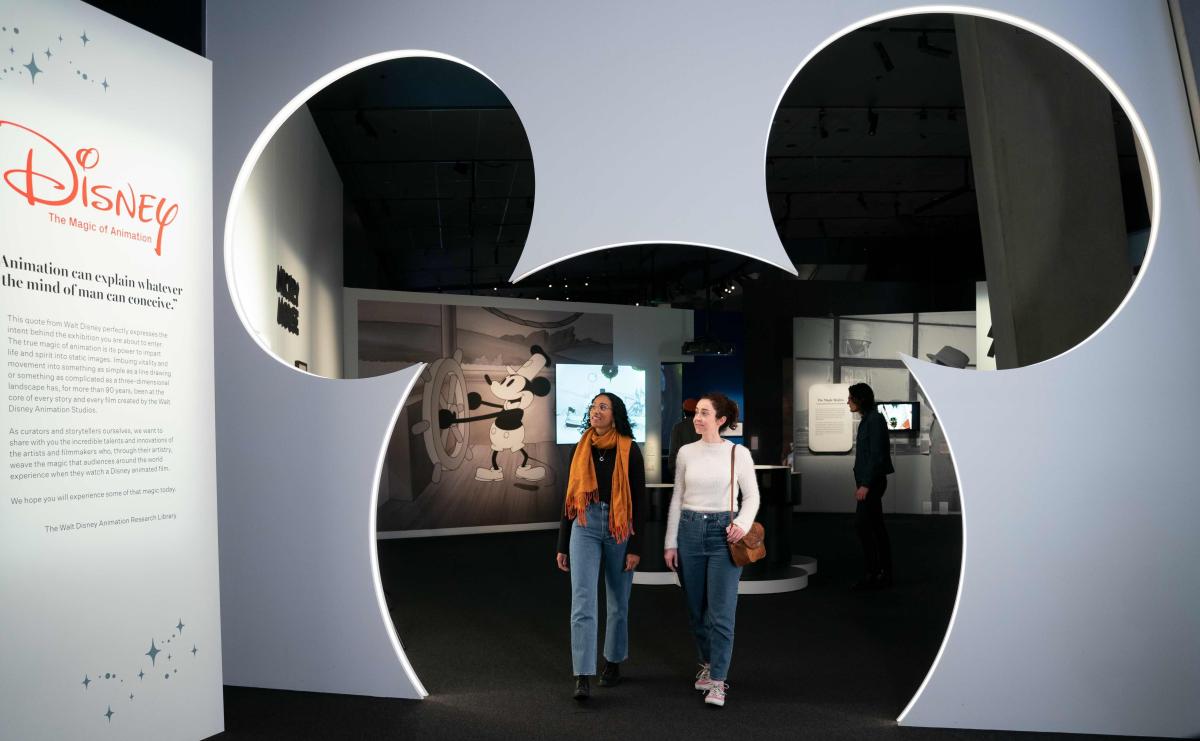As a seven-year-old, I taught myself to draw nostrils in the Disney style, by tracing a colouring book’s images hunched on the floor. It is not an overstatement to say I was in love with Disney cartoons. I was entranced by them, intoxicated by the visual style. They inspired such strong emotion in me as a kid, that love forms a significant part of the primal soup at the core of my sensibility as a cartoonist.
Disney has much less significance for my seven-year-old son, who was my reviewing companion for this exhibition. What was his favourite Disney film? ‘Star Wars, for sure.’ Er… well Disney owns Star Wars, but what about Disney cartoons? We worked out that the only one he had actually seen was Frozen. Good God! Was I a neglectful parent not exposing him to Disney classics? Well, yes, but these classics, old and new, have been diluted in such a sea of animation! Technology has made it so much cheaper to produce as time has gone on, and there are now countless TV series and movies, most made by creators weaned on Disney, spreading traces of its DNA far and wide.
This exhibition makes clear the studio’s influential innovation, and what has elevated so much of the studio’s work to a level of excellence.
This exhibition makes clear the studio’s influential innovation, and what has elevated so much of the studio’s work to a level of excellence. The exhibition begins with 1920s shorts – some of Walt Disney’s nascent studio’s earliest extended animations – then shows this leading to the creation of iconic characters in the 1930s – Mickey and Minnie Mouse, Donald Duck, Goofy. The majority of the exhibition is then devoted to significant individual films, their development and notable creative and technical features.
Read: Disney and ACMI bring the magic back to winter
Clips from the films feature prominently, illustrating key features and weaving their charm through the entire exhibition. The clips highlight less immediately obvious achievements within the films, for example one text panel points out detailed drawn water effects in Pinocchio which, we are told, animator Sandy Strother spent one whole year developing.
It is never in doubt that this is largely a Disney sanctioned production, made with the holdings of the company’s own Walt Disney Animation Research Library. I was aware that there is little analysis and no critique of the films and their much-discussed issues, such as gender representation and cultural appropriation.
Several main types of drawing from the production process are displayed, each fascinating and accomplished in its own way – explanatory storyboards, more interpretive ‘story sketches’, character sheets explaining to animators how characters should look in various poses. I loved seeing ‘Concept Sketches’ – often quite stylised works of art, created early in a film’s development, to convey the intended look and feel. Many of these offered fresh views on the evolution of familiar classics. My favourite images though were ‘Clean up Animation’ drawings – the final line drawings that are then transferred to coloured cels. These show the artists’ skill in capturing expression and movement and are the types of cartoons that have always thrilled me – a single drawn image, producing motion and emotion in a viewer’s mind, with only a few well-placed lines.
And it’s not all about Walt; a few brilliant individual artists are given credit for their contribution to the films. Mary Blair’s gorgeous concept art helped shape many early classics, including Alice In Wonderland; Tyrus Wong’s simple, evocative backgrounds for Bambi, were influenced by Chinese ink drawing; and Walt Peregoy’s distinctive ‘breezy, modernist style’ is so much a part of 101 Dalmations. The, often unheralded, brilliant cogs in these largely anonymous group projects are evident however, in the number of excellent drawings and artworks credited simply to ‘Disney Studio Artist’.
It’s hard not to compare the elaborate, stylised, water effects developed for Pinocchio with the equally brilliant but colder, photorealistic, digital water effects developed for Moana, 76 years later.
After something of a slump following the death of Walt Disney in 1966 (the films made between 1967 and 1989 are discretely omitted) the studio was revitalised with successes such as The Little Mermaid, Beauty and the Beast and The Lion King. The introduction of digital technology – beginning with Beauty and the Beast’s digitally-modelled ballroom scene – gradually dominates productions, and most recent films are generated entirely on computer rather than hand-drawn. This allows for an amazing range of composition and effects, but for me loses some of the human warmth of the older animation. It’s hard not to compare the elaborate, stylised, water effects developed for Pinocchio with the equally brilliant but colder, photorealistic, digital water effects developed for Moana, 76 years later.
The exhibition is a joyful, beautifully curated celebration of the many achievements of the studio. However, it is never in doubt that this is largely a Disney sanctioned production, made with the holdings of the company’s own Walt Disney Animation Research Library. I was aware that there is little analysis and no critique of the films and their much-discussed issues, such as gender representation and cultural appropriation.
The exhibition may lack critical engagement, but that is never really a goal here, and it gives kids and adults alike the chance to focus on the many pleasures of the Disney canon. I left with a long list of films that I couldn’t wait to watch or rewatch, and to introduce to my kids.
If I can get them to turn off Despicable Me 3.
4 stars: ★★★★
Actors:
Director:
Format:
Country:
Release:





